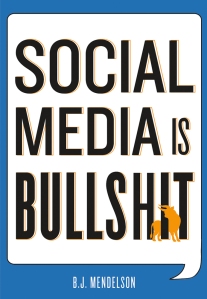With the advent and ubiquity of social media over the past 10 years, everyone seems to be a social media cheerleader, including myself. That’s when I came across a book with a completely different perspective titled Social Media is Bullshit by B.J. Mendelson. The basic premise of the book is that social media, particularly from a business standpoint, has been artificially hyped beyond actual results.
The book is separated into four parts: Social Media is Bullshit; Meet the People Behind the Bullshit; How to Sell Bullshit Without Really Trying; and How to Really Make It on the Web. Mendelson illustrates that alleged social media successes always come on heels of large corporations with big wallets, celebrity-backed promotions, and traditional media.
Mendelson states the following in his book: “Offline matters more than online. This will never change. Your location, your circumstances, your audience, that determines everything. Trying to make a niche platform on the Web is a bad idea. Not many people can do it, and most of those who do are either trying to sell you something, were in the right place at the right time, had the right connections, or get backing from the media in some form.” Mendelson’s biggest criticism is against those high-fee-charging marketing consultants and speakers who push the virtues of using social media, but cannot actually demonstrate success or ROI (return on investment) for small companies or the bootstrapping entrepreneur.
The book is 179 pages of actual content, and I was able to read it in one evening. I thought it would be a useful resource for higher education administrators and students alike, particularly those who are involved in social media marketing efforts on campus. Mendelson’s argument offers a different perspective that is rarely discussed on our campuses. To his credit, his argument holds true within the realm of higher education because hundreds of likes and retweets does not necessarily translate into higher admissions numbers, increased student engagement, and more fundraised dollars. While Social Media is Bullshit needs to be read with a grain of salt, particularly since our target market (i.e., college students) are the largest users of social media, the contents of this book would provide great content for staff development discussions and even department and institution strategic plan sessions.
Not only is the book informative, but it is entertaining as well as Mendelson writes in a very tongue-in-cheek manner. However, he is not afraid to hold punches against those he criticizes and offers many examples and case studies throughout the book. Social Media is Bullshit offers a cautionary tale for those who think that social media is a magic bullet upon which you can obtain immediate fame, money, and success.


